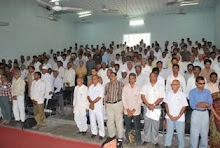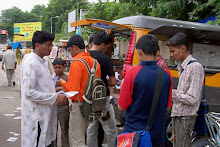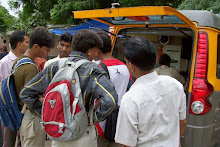Livemint: Chandana/Jind: Friday, May 03, 2013.
Sometime last
year, Surendra Singh got a call from a military outpost in Srinagar. The
soldier had an urgent inquiry for the 31-year-old sarpanch of Chandana, a
village in Haryana’s Kaithal district. The man, who hailed from the village,
had lost his voter ID card and needed a letter from the panchayat attesting
that he was indeed a resident of Chandana.
Singh
listened to him patiently, then told him to go online and look up Chandana and epanchayat.
“I told him that our village now had a website which had the scanned copies of
all the voter cards uploaded on it. All he had to do was to go online and get a
printout of his identity card,” Singh said. A 10-minute task as opposed to
something that would have taken 10 days at the best of times, the sarpanch
said.
While India
struggles to ensure the effective implementation of transparency laws such as
the Right to Information (RTI) Act and faces resistance on the part of
officialdom over posting data in the public domain, Chandana and some other
panchayats offer a refreshing contrast.
Some of
India’s smallest local self-governance units are taking their first steps
towards promoting transparency through digital empowerment and showing how it can
help. It helps that the two Haryana panchayats profiled here—Chandana and
Bibipur— both have young, educated, tech-savvy leaders who are willing to make
the extra effort to ensure that the digital strategy is meaningful.
However, for
villages like these, any digital intervention is secondary to a robust system
of governance. Panchayat members know full well that digital empowerment by
itself does not ensure the effectiveness of gram sabhas and work needs to be
done on the ground to get the full benefit of such initiatives.
The idea of
creating a dedicated website for his village panchayat occurred to Singh, a
graduate, even before he got elected to the post in 2010. “When I became the
sarpanch, everyone told me that it would be too costly an affair and that the
members may not agree to give panchayat funds for this work. However, I was
convinced that even if I had to pay from my own pocket, I would get this done,”
he said.
Singh heads a
17-member panchayat in which all the other members are older and less educated
than him. He was able to convince them that going online would work to the
advantage of the village. The panchayat’s digital initiative was supported by
the New Delhi-based non-profit organization Digital Empowerment Foundation
(DEF), which works towards creating economic and commercial viability by using
information, communication and technology (ICT).
A success
story;
One of the
main effects of digitizing panchayats is creating awareness about the Internet
and digital literacy, said Osama Manzar, DEF’s founder-director and a Mint
columnist.
“It is only
when members of panchayat in a village have a little idea about technology that
they can look at the possibilities of what more can be done through it,” said
Manzar, part of a working group on Internet proliferation and governance at the
ministry of communications and information technology.
While the
government has taken several steps to help them on their way by laying optical
fibre and developing software related to panchayat accounting, a lot more needs
to be done. “We need to aim at a certain level of digital literacy, adaptation
and creating a culture of internet connectivity,” Manzar said.
For Chandana,
the move also allowed its people to forge a bond with history. Panchayat
members and the younger people in the village became engaged in finding out
about their own past in a bid to generate content. All the information that was
collected, apart from multimedia content such as photos, were sent to DEF,
which then set up the website in 2011 and uploaded the content at no cost. The
panchayat then took the project forward by scanning in documents and posting
details about funds and meetings, keeping it relevant. Aside from serving as a
psychological boost, going digital also means higher officials can easily
access information about the village, resulting in the swifter clearing of,
say, grants. The website ensures greater visibility for the village, said
Sanjeev Kumar, a 21-year-old graduate student from Chandana who studies at a
college in Kaithal. “People in my college are always keen to know about my
village’s website. I am sure that when higher officers see the work done in our
village on the website, it would get us funds more easily,” he said.
Some 70km
away in Bibipur village in the Jind district of Haryana, digital empowerment
allows sarpanch Sunil Jaglan, 30, to save time and money by chasing up demands
with officials and making sure these are resolved by email. He stays back after
panchayat meetings to see that all relevant documents are scanned and uploaded
on the website, which boasts of Bibipur being the first “hi-tech gram
panchayat” in the country.
Participatory
governance;
“The idea is
to achieve transparency even without being asked for it. We are now in the
process of scanning and uploading nearly 3,000 pages of official documents on
our website to maximize the information available in the public domain,” Jaglan
said.
Bibipur is
atypical in some other respects as well. The panchayat has trained its focus on
female foeticide, which is significant given that it belongs to a state that
holds the dubious record of having India’s worst sex ratio in the country.
The panchayat
got permission to hold a gram sabha on female foeticide, made it compulsory for
the names of those who have not reported pregnancies in the family to be
announced at gram sabhas and instituted the practice of asking mothers who have
one girl child to inaugurate village functions.
The village
was also one of the more than 80,000 entities that sent recommendations to the
justice J.S. Verma committee that was set up to suggest ways in which India’s
laws could be strengthened to improve its awful record on women’s safety. The
committee itself was set up in response to widespread public protests against
the violent rape of a 23-year-old woman in Delhi, who eventually died of her
injuries. Bibipur sent its recommendations by email.
In Chandana
and Bibipur, the online revolution is part of a bigger picture in which young,
enlightened leaders want to make their villages a better place.
Having a
younger, educated sarpanch has helped Chandana, said Tara Chand Beniwal, a
40-year-old farmer. “Earlier, the sarpanches were not so educated and so could
not communicate very effectively. But if you are educated, you can just
directly walk up to babus and ask for your work to be done.”
This is the
last in a series of reports on panchayati raj 20 years after it was given a new
constitutional framework.















































































